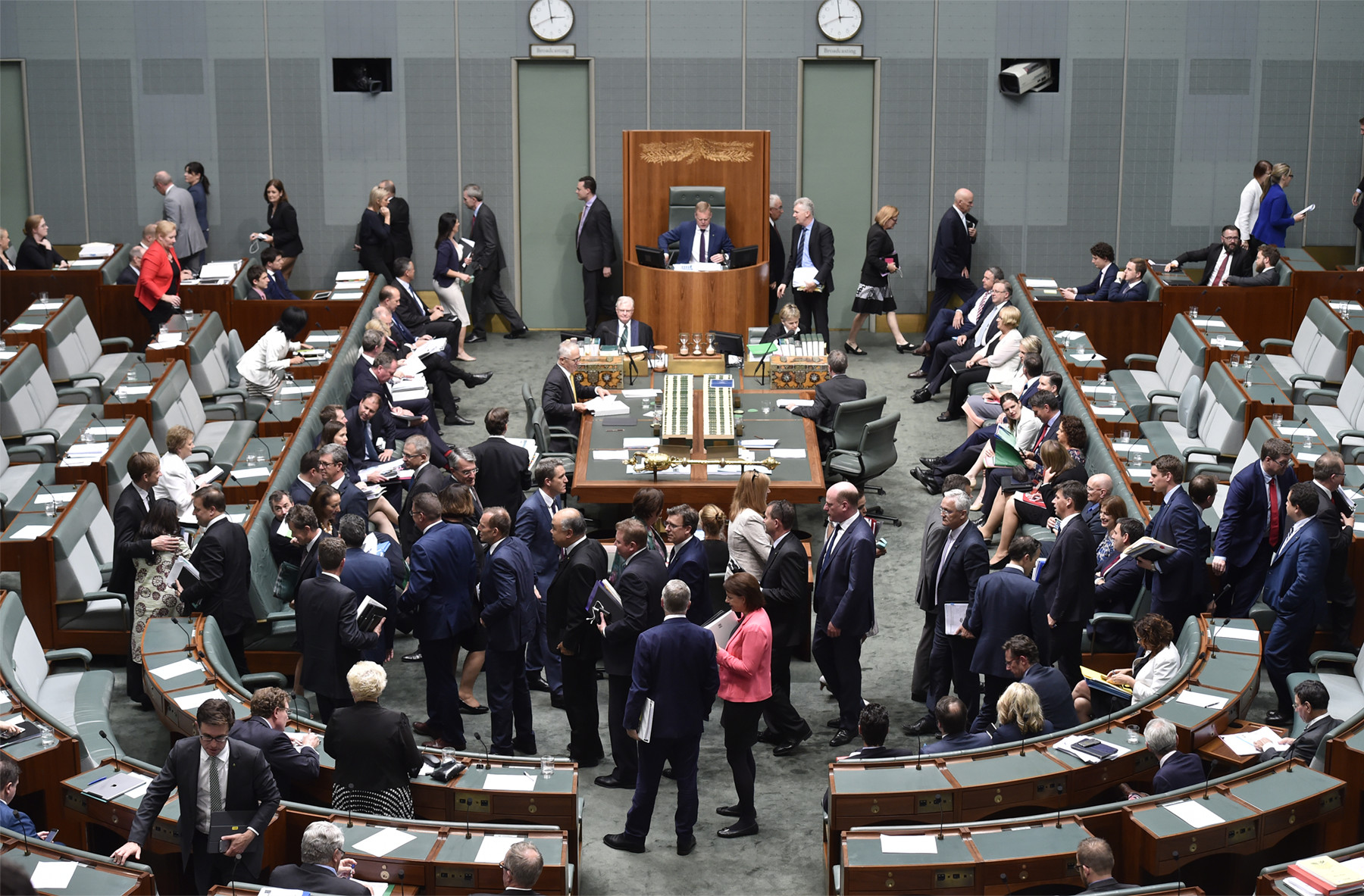Voting in Parliament
Learn about voting in Australian Parliament with this fact sheet. It explains the 2 types of voting methods used to make decisions, and what happens when a vote is tied.
What will I learn?
- The Australian Parliament makes decisions on proposed laws and other issues by a majority vote.
- Decisions are made 'on the votes' or by a division.
- Most decisions of the Parliament are made by voting ‘on the voices’.
Why is there voting in Parliament?
The House of Representatives during a division

DPS AUSPIC
Description
A formal vote called a division happening in the House of Representatives. Members are dividing into two groups. Those voting 'aye' or 'yes' are moving to sit on one side of the House and on those voting 'no' are moving to sit on the other side.
Copyright information
Permission should be sought from DPS AUSPIC for third-party or commercial uses of this image. To contact DPS AUSPIC email: auspic@aph.gov.au or phone: 02 6277 3342.
The House of Representatives during a division

DPS AUSPIC
Description
A formal vote called a division happening in the House of Representatives. Members are dividing into two groups. Those voting 'aye' or 'yes' are moving to sit on one side of the House and on those voting 'no' are moving to sit on the other side.
Copyright information
Permission should be sought from DPS AUSPIC for third-party or commercial uses of this image. To contact DPS AUSPIC email: auspic@aph.gov.au or phone: 02 6277 3342.
Voting is used in the Australian Parliament to make decisions on proposed laws and other issues. These decisions are made by a majority vote. Proposals, called motions, are debated and then votes are taken. Votes in Parliament can be taken using 2 methods – ‘on the voices’ and a division.
On the voices
When a decision needs to be made in either the Senate or House of Representatives, it is first put to a vote ‘on the voices'. Most decisions of the Parliament are made this way. This is a spoken vote with no record taken of individual votes.
After debate on the motion has finished, the Presiding Officer – the President of the Senate or Speaker of the House of Representatives:
- 'puts' – asks – the question
- directs members of parliament who want to vote for the proposal to say ‘aye’ and those against it to say ‘no’
- declares the result based on which response had the majority of voices.
If no-one challenges the result, the matter is decided. If the result is challenged by more than one member of parliament, a division is called.
Lights flashing on a clock at Parliament House

Parliamentary Education Office (peo.gov.au)
Description
In Australian Parliament House, the clocks show when a division – a formal vote – is about to happen. A red light between the 7 and 8 on the clock face flashes when a vote is to occur in the Senate. A green light between the 4 and 5 flashes to indicate a vote in the House of Representatives.
Copyright information
This work is licensed under a Creative Commons Attribution-NonCommercial-NoDerivs 3.0 Unported License.
You are free to share – to copy, distribute and transmit the work.
Attribution – you must attribute the work in the manner specified by the author or licensor (but not in any way that suggests that they endorse you or your use of the work).
Non-commercial – you may not use this work for commercial purposes.
No derivative works – you may not alter, transform, or build upon this work.
Waiver – any of the above conditions can be waived if you get permission from the copyright holder.
Division
A division is a formal recorded vote where members of Parliament divide into two groups to vote for or against a proposal.
If a division is called:
- the Clerk presses a button on their table, which activates bells inside the about 2600 clocks in Parliament House
- lights flash on the clocks to show where the division is being called – a red light for the Senate and a green light for the House of Representatives. This tells members of parliament who are not present that a division is about to happen
- the division bells usually ring for 4 minutes. If divisions are held one after another, the bells can ring for one minute. Once the bells have stopped, the doors are locked
- members of parliament who arrive after the bells stop are not allowed to enter
- the Presiding Officer asks those who want to vote for the proposal to move to the right side of their chair, and those voting against to move to the left. Votes are counted and the names of those voting are recorded
- the result is announced by the Presiding Officer.
Tied votes
In the House of Representatives, the Speaker of the House does not vote unless the result is a tie. If there is a tie, the Speaker has the casting vote to decide the matter.
The President of the Senate may always vote along with other senators. This ensures all the states have equal representation when votes are taken in the Senate. If there is a tied vote in the Senate, the question is not agreed to because a majority vote has not been achieved.
